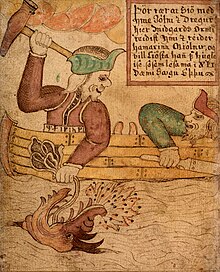Hymiskviða

Hymiskviða ( old north. The song of Hymir ) is a so-called song of the gods of the song Edda . The song is handed down in 39 stanzas in the Eddic meter of the Fornyrðislag both in the body of the Codex Regius and in the manuscript AM 748 4 ° . The song was probably written in the 12th or 13th century. The song is named after the giant Hymir , who acts as a kind of antagonist to the main character of the god Thor . The plot and the drawing of the figures clearly show fluctuating features. The main motif of the plot is the plot of the Thor myth of the fishing of the Midgard serpent or also called Thor's fishing move . This motif was subject to a multiple reception in Old Norse literature, especially in the scald poetry ( Þórsdrápa ) and in the fine arts in the form of sculptural attachments on rune and picture stones .
action
The poem tells of the sir who visited Ægir . They found that he had many pots to cook with and that he should be their host. Ægir agreed on the condition that the sir bring a pot large enough to cook food for all of them.
Such a large pot could not be found easily, but Týr , the son of Odin , remembered that his "father Hymir" (a contradiction to the Prose Edda , in which Odin is called the father of Tyr) such a large pot owned. After that, the sir left for Hymir's home.
Arrived at Hymir, Thor ate so much of Hymir's food that they both had to go outside to fish because Thor's appetite had emptied Hymir's pantry. The poem goes on to tell how Thor almost caught the Midgard serpent , demonstrating his strength, but Hymir mocked him, saying that he could not possibly be strong unless he could break Hymir's drinking cup. The cup was magical and could only be destroyed by throwing it against Hymir's skull. Thor, who knew about this, threw the cup against Hymir's skull (or helmet), causing it to break. The angry Hymir then tells the sir to take the pot and leave.
Section from the Hymiskviða
Translation by Karl Joseph Simrock (1851):
- The Earthly Patron was hooked
- The bull's head as bait to fight the worm.
- Yawning, the god-hated one caught
- Belted around the earth after such an etching.
- Thôr the mighty drew bravely
- The shimmering poison worm up to the edge of the ship.
- He hit the ugly head with the hammer,
- The rock solid, the friend of the wolf.
- Rocks crashed, cracks howled,
- The old earth started with a groan:
- Then the fish sank into the sea.
Illustrations from the Viking Age
The fishing scene on the Altuna Runestone in the province of Uppland in Sweden displayed. On it you see Thor standing in the bot with the raised hammer Mjölnir .
Another illustration can be found on the Gosforth Cross in the town of Gosforth in Cumbria , England .
Newer pictures
Oil painting by Johann Heinrich Füssli from 1788.
Illustration from Fredrik Sanders Edda edition from 1893.
Arthur Rackham's 1901 interpretation.
Interpretation by Lorenz Frölich in Viktor Rydberg's Teutonic Mythology from 1906.
Thor slaughters the ox he wants to use as bait. Illustration by WG Collingwood from Olive Bray's 1908 Edda translation.
literature
- Heinrich Beck (philologist) : Hymiskviða. In: Reallexikon der Germanischen Altertumskunde (RGA). 2nd Edition. Volume 15, Walter de Gruyter, Berlin / New York 2000, ISBN 3-11-016649-6 , pp. 300-305.
- Klaus von See , Beatrice La Farge, Eve Picard, Ilona Priebe, Katja Schulz: Commentary on the songs of the Edda. Vol. 2: Songs of the Gods (Skírnismál, Hárbarðslióð, Hymiskviða, Lokasenna, Þrymskviða). Winter, Heidelberg 1997, ISBN 3-8253-0534-1 .
- Rudolf Simek , Hermann Pálsson : Lexicon of old Norse literature. The medieval literature of Norway and Iceland (= Kröner's pocket edition . Volume 490). 2nd, significantly increased and revised edition. Kröner, Stuttgart 2007, ISBN 978-3-520-49002-5 .
Web links
- Hymiskviða on Norrøn.
Individual evidence
- ↑ HYMISKVIÐA - ÞÓRR DRÓ MIÐGARÐSORM ( Memento of the original from March 19, 2014 in the Internet Archive ) Info: The archive link was inserted automatically and has not yet been checked. Please check the original and archive link according to the instructions and then remove this notice. . University of Iceland website. Retrieved February 22, 2014.
- ↑ HYMISKVIÐA 05 ( page no longer available , search in web archives ) Info: The link was automatically marked as defective. Please check the link according to the instructions and then remove this notice. . University of Iceland website. Retrieved February 22, 2014.












